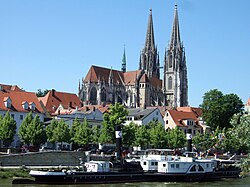Regensburg Cathedral
| Saint Peter's Cathedral | |
|---|---|
| Regensburger Dom | |

Regensburg Cathedral, in the foreground the Danube.
|
|
| 49°01′10″N 12°05′54″E / 49.01944°N 12.09833°ECoordinates: 49°01′10″N 12°05′54″E / 49.01944°N 12.09833°E | |
| Location | Regensburg |
| Country | Germany |
| Denomination | Roman Catholic |
| Website | Website |
| Architecture | |
| Status | Active |
| Functional status | Cathedral |
| Completed | 1520 |
| Specifications | |
| Length | 85.40 m (280 ft 2 in) |
| Width | 34.80 m (114 ft 2 in) |
| Height | 31.85 m (104 ft 6 in) |
| Number of spires | 2 |
| Spire height | 105 m (344 ft 6 in) |
| Administration | |
| Diocese | Diocese of Regensburg |
| Clergy | |
| Bishop(s) | Rudolf Voderholzer |
The Regensburg Cathedral (German: Dom St. Peter or Regensburger Dom), dedicated to St Peter, is the most important church and landmark of the city of Regensburg, Germany. It is the seat of the Catholic diocese of Regensburg. The church is the prime example of Gothic architecture in Bavaria.
A first bishop's church was built around 700, at the site of the present-day cathedral parish church Niedermünster (St. Erhard's tomb). Around 739, St. Boniface chose the area of the Porta Praetoria (North Gate of the old Roman fort) for the bishop's seat, and the site of the cathedral has remained there since. The Cathedral was rebuilt in Carolingian times and expanded in the early 11th century, with an approximately 15-meter-wide transept, two towers and an atrium.
In 1156-1172 the edifice burnt twice, and was also rebuilt starting from 1273 in High Gothic style. The three choirs of the new cathedral were ready for use in 1320, while the old cathedral was demolished at the same time. In 1385-1415 the elaborate main entrance to the west was completed, with the most of the new edifice being finished around 1520; the cloister was constructed in 1514-1538.
The cupola at the transept crossing and other sectors were renovated in Baroque style in the 17th century. In 1828-1841 the cathedral underwent a neo/Gothic restoration commissioned by King Ludwig I of Bavaria. The Baroque frescoes were relocated and the cupola demolished, being replaced by a quadripartite rib vault. The towers and their spires were built in 1859-1869. Three years later the cathedral was finally finished, with the completion of the transept gable and the spire (at the crossing), after some 600 years of construction.
The state-run Dombauhütte (Cathedral building workshop) was founded in 1923, for the ongoing oversight, maintenance, and restoration of the cathedral. In the 1980s construction of the crypt mausoleum and archeological exploration of the center nave (partial exposure of a former southern arcade entrance to the atrium of a precursor Roman structure) were carried on.
...
Wikipedia

